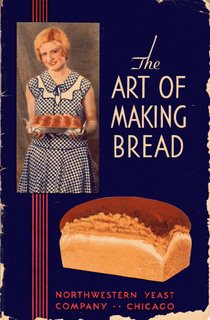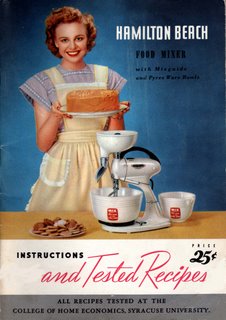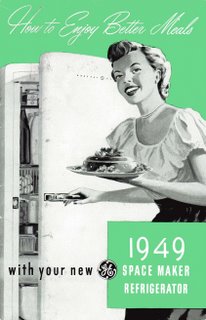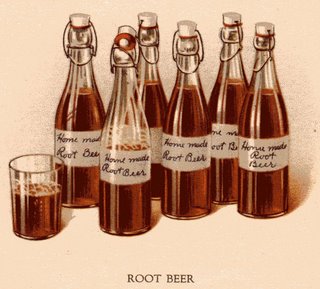Cheese and Ways to Serve It (Kraft-Phenix Cheese Corporation, 1933).
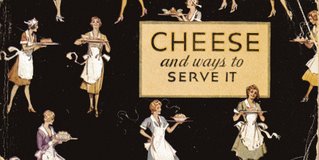 What a cute little booklet! It’s sort of the dimensions of a recipe card, only a little longer, and the pages are perforated so you can tear out the recipes and put them in your recipe card file. The recipes are all cheese-related and mostly are variations on a few common themes: Cheese Sauce Poured Over Something, Macaroni and Cheese Molded or Stuffed Into Things, “Loaves” Made of Ground-Up Things with Cheese Functioning as Glue, or Fancy Party Sandwiches Made with Cream Cheese or Cheese Spreads. Practically all feature glutinous processed cheeses, mainly American or Velveeta. A lovely presentation of typical recipe-booklet convenience-food fare.
What a cute little booklet! It’s sort of the dimensions of a recipe card, only a little longer, and the pages are perforated so you can tear out the recipes and put them in your recipe card file. The recipes are all cheese-related and mostly are variations on a few common themes: Cheese Sauce Poured Over Something, Macaroni and Cheese Molded or Stuffed Into Things, “Loaves” Made of Ground-Up Things with Cheese Functioning as Glue, or Fancy Party Sandwiches Made with Cream Cheese or Cheese Spreads. Practically all feature glutinous processed cheeses, mainly American or Velveeta. A lovely presentation of typical recipe-booklet convenience-food fare.Graphic Design: A real favorite. The size, shape, and detachable pages make it incredibly cute. Inside is clean and modern-looking, with some feminine touches softening things up a bit.
Illustrations: This has one of the best covers ever––cute apron-bedecked 30s housewives frolic and serve up cheese dishes on a black background. Inside are very nice color illustrations of food and lots of black-and-white spot illustrations of housewives.
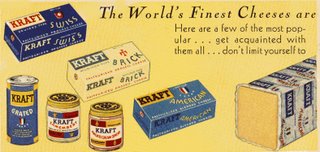 Look at all the different kinds of processed cheese products you can get!
Look at all the different kinds of processed cheese products you can get! You can even get Limburger!
You can even get Limburger! This was from back in the days when "salad" meant a bizarre little piece of food art parked on a lettuce leaf.
This was from back in the days when "salad" meant a bizarre little piece of food art parked on a lettuce leaf. No, it's not a cake, it's a party sandwich loaf!
No, it's not a cake, it's a party sandwich loaf! It's not just Welsch Rabbit on Toast, it's Electric Welsch Rabbit on Toast!
It's not just Welsch Rabbit on Toast, it's Electric Welsch Rabbit on Toast! Gee, Mom, isn't that bridge built yet?
Gee, Mom, isn't that bridge built yet? Velveeta-stuffed toast logs! Mmmmmmmm!
Velveeta-stuffed toast logs! Mmmmmmmm! For a truly elegant dessert, serve blocks of processed cheese on a cheese and fruit tray! OK, maybe not...
For a truly elegant dessert, serve blocks of processed cheese on a cheese and fruit tray! OK, maybe not...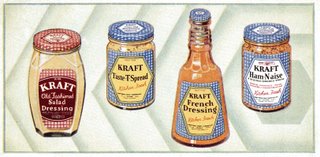 I love these cute little product illustrations.
I love these cute little product illustrations.Menus: 8.
Recipes containing Limburger cheese: None, unfortunately, although Kraft did make it at that time (there’s a picture of the package on page 5).
Great Recipe Names: Macaroni Mousse, Cheese Dreams.
Great Product Names: Kraft Kay, Kraft Taste-T-Spread, Kraft Ham-N-aise.
Sample Menu:
Afternoon Tea
“Philadelphia” Cream Cake
Coffee
Sample Recipes:
Macaroni Stuffed Peppers
5 green peppers
1 cup cooked macaroni
1 1/2 cups grated Kraft American Cheese or Velveeta
1 cup cooked tomatoes
1 cup bread crumbs
1 teaspoon Worcestershire sauce
Salt, pepper, paprika
1 can tomato soup
Remove tops and seeds from peppers and boil 5 minutes in salted water. Mix macaroni, 1 cup of cheese, tomatoes, crumbs, Worcestershire sauce and seasonings to taste. Drain the peppers and stuff with macaroni mixture. Stand upright in a baking dish, sprinkle remainder of cheese on top and pour around them the tomato soup slightly diluted with water. Bake in a moderate oven, 350°, 30 to 40 minutes.
Cheese-Bean Roast
1 lb. can kidney beans
1/2 lb. Kraft American Cheese or Velveeta
1 onion, chopped fine
1 tablespoon butter
1 cup bread crumbs
Salt, peppper, paprika
2 eggs
Drain liquid from beans, run beans and cheese through a food grinder. Cook onion in butter. Combine ingredients, add seasonings and beaten eggs. Mold into a loaf or roll, moisten with melted butter and water and roll in bread crumbs; or pack firmly in a buttered baking dish and cover the top with buttered crumbs. Bake in a moderate oven, 350°, until nicely browned. Serve with tomato sauce.









